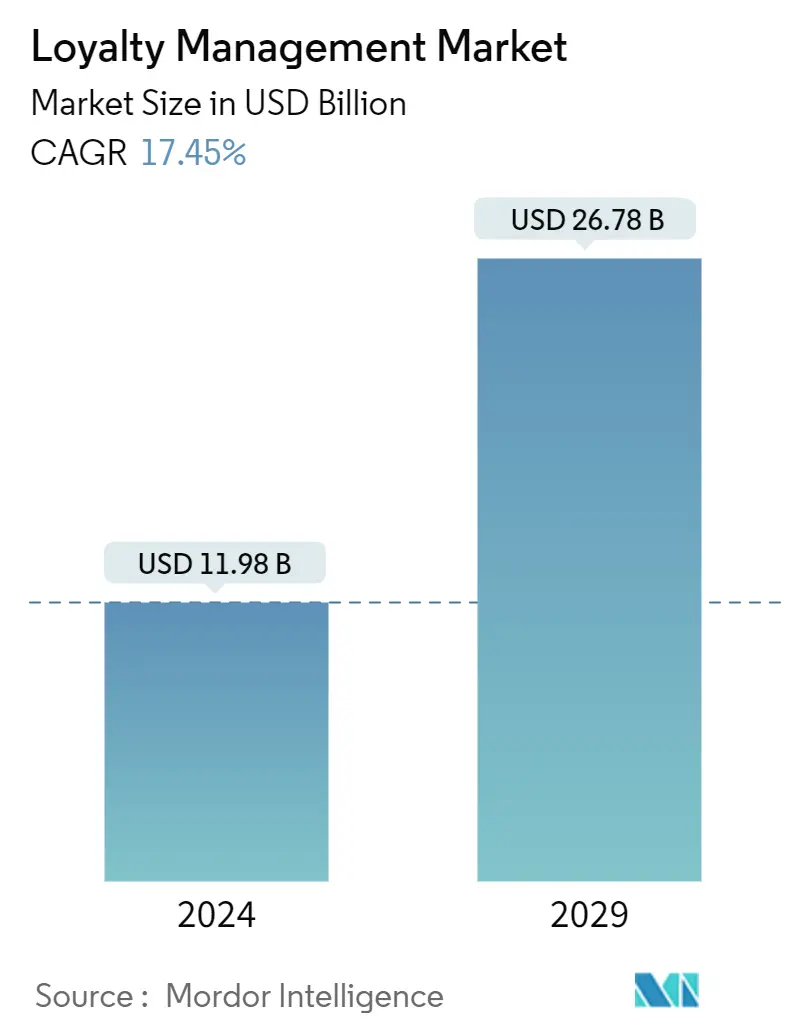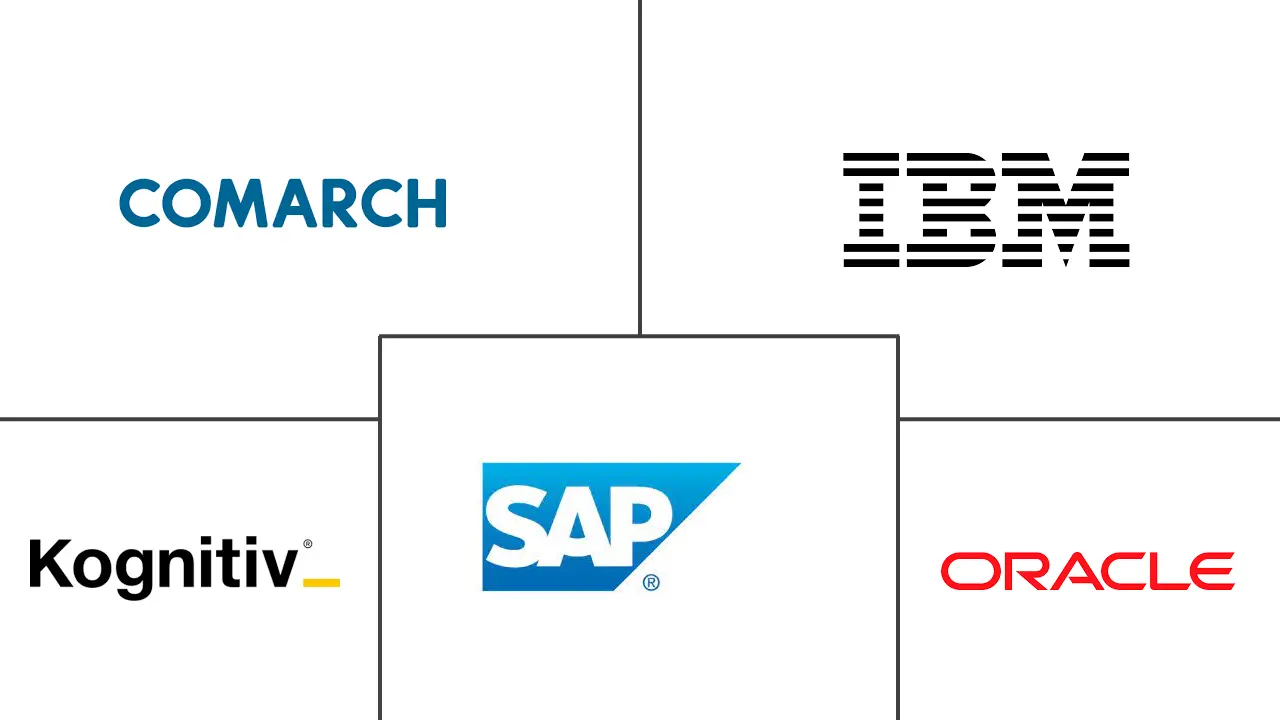Market Size of Loyalty Management Industry

| Study Period | 2019 - 2029 |
| Market Size (2024) | USD 11.98 Billion |
| Market Size (2029) | USD 26.78 Billion |
| CAGR (2024 - 2029) | 17.45 % |
| Fastest Growing Market | Asia Pacific |
| Largest Market | North America |
Major Players
*Disclaimer: Major Players sorted in no particular order |
Loyalty Management Market Analysis
The Loyalty Management Market size is estimated at USD 11.98 billion in 2024, and is expected to reach USD 26.78 billion by 2029, growing at a CAGR of 17.45% during the forecast period (2024-2029).
The Loyalty Management Market size is estimated at USD 11.98 billion in 2024, and is expected to reach USD 26.78 billion by 2029, growing at a CAGR of 17.45% during the forecast period (2024-2029).
A loyalty management system is a marketing automation software used to develop, oversee, and evaluate the effectiveness of loyalty programs. Solutions for loyalty programs can be integrated into the company CRM system as a built-in feature or as a separate platform. The information required to operate customized loyalty programs is retrieved from data sources through API, and the chosen front-end receives the information from the loyalty software.
- The loyalty programs aim to establish consumer engagement to understand and influence their purchasing behavior. Factors such as the rising expansion of the e-commerce and retail market and the shift toward a consumer-centric approach by business organizations are primary factors driving the market's growth. The increasing penetration of smartphones worldwide and improving internet services have facilitated easy access to the Internet, encouraging market growth across regions.
- According to Antavo Global Customer Loyalty Report 2023, which surveyed 260 corporate individuals, 88.5% of respondents trust loyalty programs to overcome the inflation crisis and potential recession. 67.7% of respondents plan to increase or significantly increase their investments in customer retention. 80.0% of companies that measure the return on investments (ROI) of their loyalty programs reported a positive ROI with, on average, 4.9 times more revenue than their expenses. Such positive responses state that the demand for loyalty management tools would increase over the forecasted period.
- Furthermore, 78.6% of respondents with a current loyalty program are likely to revamp their program, a seven-percentage point increase over last year. The average annual spend of customers who redeem personalized offers is 4.5 times higher than those who have never taken advantage of such requests. Strategic partnerships, linking payment cards to loyalty programs, and supporting ESG (Environmental, Social, and Governance) causes were identified as top trends for the following years.
- Ongoing digitalization and the increasing importance of enhancing consumer experience are shaping the loyalty management market. The emergence of innovative technologies such as artificial intelligence and machine learning aids in understanding consumer preferences. These technologies can project purchase probability, customer loyalty, and estimated revenue generation. In addition, the trend of personalization and customization can increase buyer satisfaction, and the conversion rate of potential buyers is also propelling market growth. The adoption of Loyalty management increases both loyalty and sales. It predicts the risk of leaving and shifting from a particular product.
- A lack of awareness about loyalty programs can hinder the growth of the loyalty management market. It has been observed that many members of loyalty programs lack an understanding of their point balance and the absence of a redemption goal. To overcome this, marketers are creating awareness by building up expectations before the launch of a product concerning the loyalty benefits. However, companies focus on product marketing/promotion rather than creating awareness about loyalty benefits, thus restricting the market's growth.
- In the post-pandemic scenario, loyalty programs are having a renaissance in providing this entrenched brand attachment. For instance, in November 2022, Enterprise Loyalty Cloud platform Antavo successfully closed its Series A round at EUR 10 million (~USD 10.86 million) led by Euroventures alongside Lead Ventures, Europe and Innovation Nest and private investors, including Zoltan Vardy, empowering the company to develop its best-in-class software as a service (SaaS) platform.
Loyalty Management Industry Segmentation
Loyalty management is a marketing approach based on strategic management, in which a company focuses on growing and retaining existing customers through incentives. These are web-based tools deployed for the management of loyalty programs across key end-user segments and for efficient identification, implementation, and tracking of loyalty programs. Businesses can use it to identify (potential) repeat customers and encourage them to buy more by giving them gift cards, coupons, and other incentives.
The loyalty management market is segmented by solution (b2c, b2b, and corporate), deployment (on-premise and on-demand), industry verticals (BFSI, consumer goods and retail, healthcare, IT and telecom, travel and hospitality, manufacturing, and other industry verticals), and geography (North America (the United States and Canada), Europe (Germany, United Kingdom, France, Italy, and Rest of Europe), Asia Pacific (Thailand, Indonesia, Malaysia, Singapore, China, Japan, India, Australia, and Rest of Asia Pacific), Latin America (Brazil, Argentina, Mexico, and Rest of Latin America), and Middle East and Africa (United Arab Emirates, Saudi Arabia, South Africa, Nigeria, and the Rest of the Middle East and Africa). The market sizes and forecasts are provided in terms of value in (USD) for all the above segments.
| By Solution | |
| B2C | |
| B2B | |
| Corporate |
| By Deployment | |
| On-Premise | |
| On-Demand |
| By Industry Vertical | |
| BFSI | |
| Consumer Goods and Retail | |
| Healthcare | |
| IT and Telecom | |
| Travel and Hospitality | |
| Manufacturing | |
| Other Industry Verticals |
| By Geography | |||||||||||
| |||||||||||
| |||||||||||
| |||||||||||
| |||||||||||
|
Loyalty Management Market Size Summary
The loyalty management market is poised for significant growth, driven by the increasing emphasis on consumer engagement and the adoption of technology-driven solutions. As businesses shift towards a more consumer-centric approach, loyalty management systems have become essential tools for understanding and influencing purchasing behavior. These systems, which can be integrated into existing CRM platforms or used as standalone solutions, leverage data from various sources to create customized loyalty programs. The rise of e-commerce, the proliferation of smartphones, and improved internet access have further fueled market expansion, enabling businesses to offer more personalized and accessible loyalty experiences. The market is characterized by a competitive landscape with numerous players, including major corporations like Kognitiv Corporation, IBM, and Oracle, all vying to capture a larger share by introducing innovative solutions and forming strategic partnerships.
In the B2C sector, loyalty management programs are increasingly being tailored to enhance customer experiences and drive retention. The growing use of smartphones has led to the development of mobile-oriented loyalty programs, allowing consumers to engage with brands more seamlessly and conveniently. This trend is particularly evident in regions like Asia-Pacific, where countries such as China, Japan, and Indonesia are witnessing a surge in loyalty program adoption across various industries. Despite the market's potential, challenges such as a lack of awareness about loyalty benefits and the need for more intuitive program designs persist. However, ongoing digitalization and the integration of advanced technologies like AI and machine learning are expected to address these issues, further propelling market growth. As companies continue to invest in loyalty management tools, the market is set to experience robust expansion, with businesses increasingly recognizing the value of customer retention and engagement strategies.
Loyalty Management Market Size - Table of Contents
-
1. MARKET INSIGHTS
-
1.1 Market Overview
-
1.2 Industry Attractiveness - Porter's Five Forces Analysis
-
1.2.1 Bargaining Power of Suppliers
-
1.2.2 Bargaining Power of Buyers
-
1.2.3 Threat of New Entrants
-
1.2.4 Threat of Substitutes
-
1.2.5 Intensity of Competitive Rivalry
-
-
1.3 Value Chain Analysis
-
1.4 Impact of COVID-19 on the Loyalty Management Market
-
-
2. MARKET SEGMENTATION
-
2.1 By Solution
-
2.1.1 B2C
-
2.1.2 B2B
-
2.1.3 Corporate
-
-
2.2 By Deployment
-
2.2.1 On-Premise
-
2.2.2 On-Demand
-
-
2.3 By Industry Vertical
-
2.3.1 BFSI
-
2.3.2 Consumer Goods and Retail
-
2.3.3 Healthcare
-
2.3.4 IT and Telecom
-
2.3.5 Travel and Hospitality
-
2.3.6 Manufacturing
-
2.3.7 Other Industry Verticals
-
-
2.4 By Geography
-
2.4.1 North America
-
2.4.1.1 United States
-
2.4.1.2 Canada
-
-
2.4.2 Europe
-
2.4.2.1 Germany
-
2.4.2.2 United Kingdom
-
2.4.2.3 France
-
2.4.2.4 Italy
-
2.4.2.5 Rest of Europe
-
-
2.4.3 Asia Pacific
-
2.4.3.1 Thailand
-
2.4.3.2 Indonesia
-
2.4.3.3 Malaysia
-
2.4.3.4 Singapore
-
2.4.3.5 China
-
2.4.3.6 Japan
-
2.4.3.7 India
-
2.4.3.8 Australia
-
2.4.3.9 Rest of Asia Pacific
-
-
2.4.4 Latin America
-
2.4.4.1 Brazil
-
2.4.4.2 Argentina
-
2.4.4.3 Mexico
-
2.4.4.4 Rest of Latin America
-
-
2.4.5 Middle East and Africa
-
2.4.5.1 United Arab Emirates
-
2.4.5.2 Saudi Arabia
-
2.4.5.3 South Africa
-
2.4.5.4 Nigeria
-
2.4.5.5 Rest of Middle East and Africa
-
-
-
Loyalty Management Market Size FAQs
How big is the Loyalty Management Market?
The Loyalty Management Market size is expected to reach USD 11.98 billion in 2024 and grow at a CAGR of 17.45% to reach USD 26.78 billion by 2029.
What is the current Loyalty Management Market size?
In 2024, the Loyalty Management Market size is expected to reach USD 11.98 billion.

